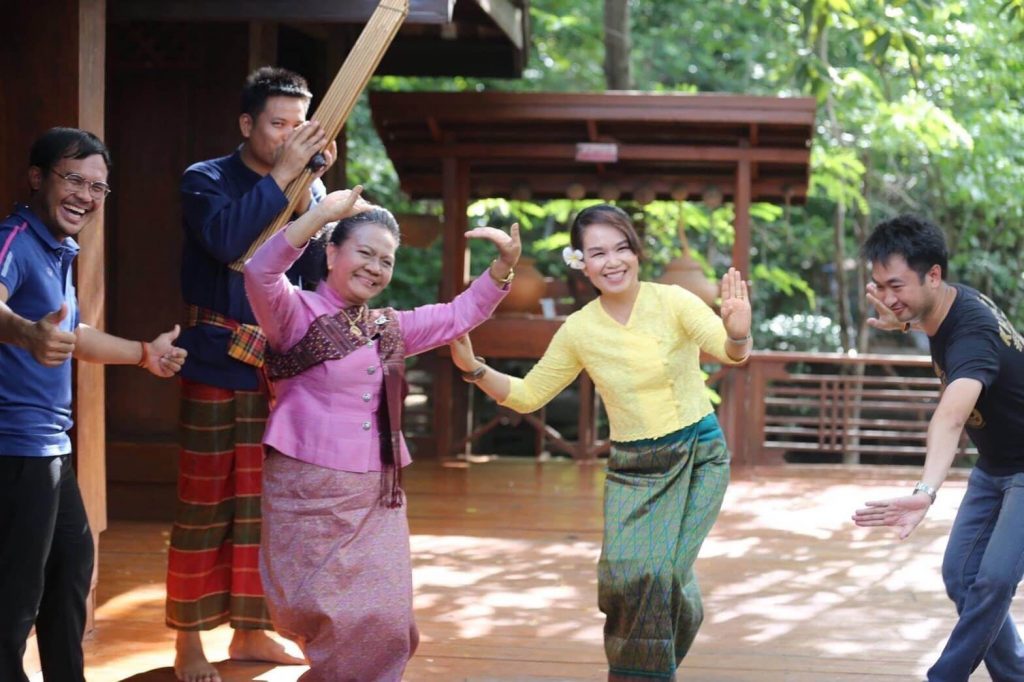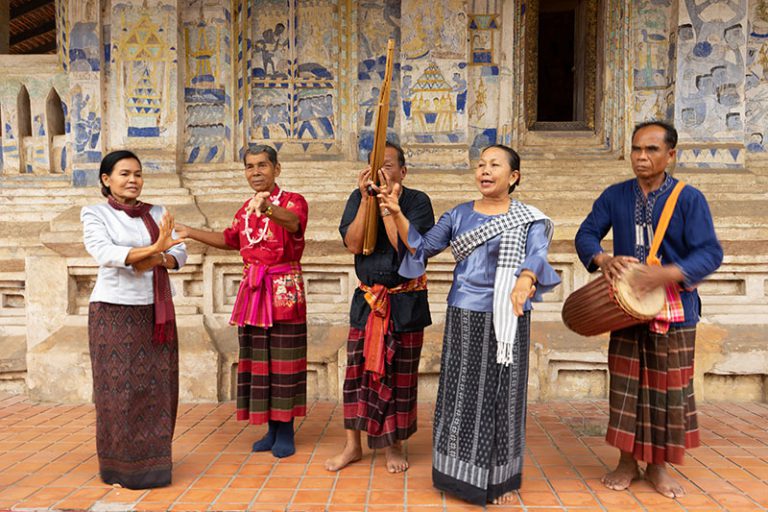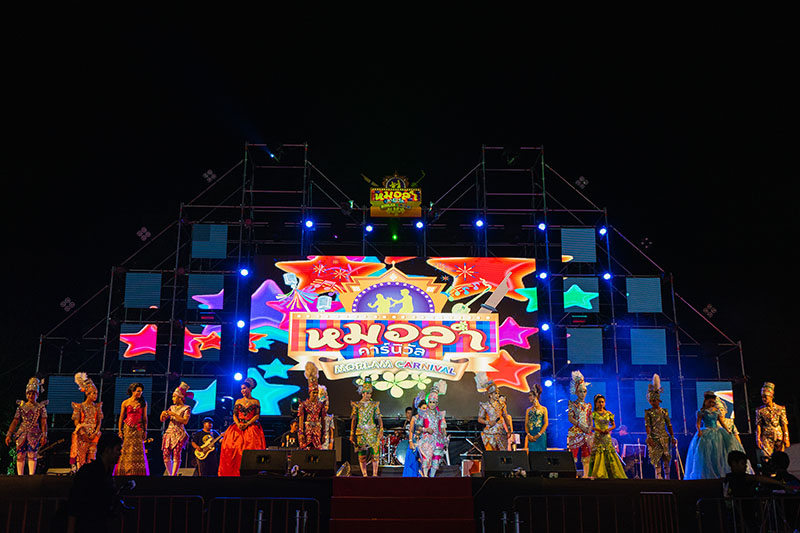Mor Lam – The Spirit of Isan

[cr. prachachat]
Although Khon and Nora are often proclaimed as the greatest feats of classical Thai theatrical arts, those who admire legacies of Thai culture would find that another, Northeastern art form by the name of Mor Lam [หมอลำ] is as enthralling. In Isan, as Northeastern Thailand is also often called, Mor Lam is often considered the pinnacle of regional theater, harboring the adoration of Isan people as the Khon and Nora do for Central and Southern Thais.
Mor Lam is a combination of two Thai words. “Mor” [หมอ] can refer to someone blessed with knowledge. “Lam” [ลำ] means to sing in a certain tune or rhythm. The words Mor Lam can refer to two different, but related, things. First, as we have discussed it so far, Mor Lam can refer to a genre of Thai theatrical arts. However, Mor Lam can also refer to the practitioners of the Mor Lam genre, who are imbued with the knowledge to perform.
The Origins of Mor Lam
There are no definitive records of where Mor Lam began. However, many speculate that the first performance was conducted as part of a religious procession. Speculators theorize that while people were wishing for blessings from deities, they were most likely reading ancient scriptures to make their prayers, and because the readings presented a compilation of entertaining stories, believers ultimately incorporated storytelling tones, vocal techniques, and percussion instruments into their recitations.
Others, however, believe that Mor Lam originated from an evening activity in Isan, when people gathered at sunset to relax and catch up. Under this theory, people took turns sharing the highlight of their laborious day or week, or sometimes just tidbits they found interesting. Through Mor Lam, they were uplifted and able to enjoy a little bit of entertainment and humor.

[cr. nairobroo.com]
Those who presented themselves as good storytellers often drew large crowds. Ultimately, they rehearsed enough to become storytellers performing at lively pageants. Those who did not have such a platform would still be able to set up their own makeshift show, turning Mor Lam into a viable profession.
Even though Mor Lam might have begun as a slow and unusual activity to end the day, it later evolved into an active performance. Performers, knowing that their popularity depended on their use of gestures, rhyme, and melody, became conscious about their game. For those sharing stories from a canon — which became a practice (an example of a story sometimes used was Karaket and Sinsai) — they learned how to draw out short stories to suit the demands of audiences, who had begun to crave more. Plus, as showing became an important element of the entertainment, the storytellers began to enact the roles of the heroes and heroines while they sang. They also began to include instruments, the popular ones being the seung, the saw u, the pi, and the khaen — a combination of string and wind instruments. Of all these, the khaen is the most iconic for Mor Lam.
Different Styles of Mor Lam
Early Mor Lam performances were referred to as “lam puen” [ลำพื้น], which featured stories from Buddhist literature, such as the Jataka Tales, or local stories. Typically, there was only one performer, a man accompanied by the khaen. He would use a versatile loincloth called “Pa kao ma” as a prop to play the roles of hero, heroine, or warriors.
Nowadays, Mor Lam is performed by both men and women and is usually much flashier. Having both genders has allowed Mor Lam to include more storylines, particularly romance. Furthermore, having a mixed-gender cast allows for more relatability with the audience.

Chaweewan Dumnern, the Queen of Mor Lam [cr. Thai PBS]
Today’s Mor Lam is performed in various styles. Each category bears its own unique characteristics and techniques. Broadly speaking, Mor Lam can be divided into Mor Lam koo [หมอลำคู่] -paired Mor Lam- and Mor Lam moo [หมอลำหมู่] – group Mor Lam, with more than two performers. Over those two categories, some common styles of Mor Lam are:
- Mor Lam reuang [หมอลำเรื่อง] — storytelling using Thai folktales
- Mor Lam ploen [หมอลำเพลิน] — upbeat singing and dance inspired by Thai country music and pop culture
- Mor Lam toey [หมอลำเต้ย] — fun, short songs that often take a flirtatious nature
- Mor Lam klon [หมอลำกลอน] — a poetry performance where storytellers respond to one another with rhymes concocted live (the content covers anything from morality to politics, or history and tradition)
- Mor Lam sing [หมอลำซิ่ง] — a sub-genre that emphasizes fun, built on the Mor Lam ploen; it plays for only about ten to fifteen minutes but amplifies the flashiness (for instance, with glitzy dancers and frantic music, which can include a bass guitar). “Sing” [ซิ่ง] is believed to have come from the English word “racing”, and Mor Lam sing was helpful for the comeback of Mor Lam, which temporarily lost popularity due to the influx of other music and entertainment options in modern times.
- Mor Lam ching choo [หมอลำชิงชู้] — a competition for love in which the man or the woman who concocts the best rhyme wins over the heart of the coveted character
Other types of Mor Lam are Mor Lam pee fah [หมอลำผีฟ้า] and Mor Lam yao [หมอลำเหยา]. These two sub-genres are meant for healing the sick and predicting the weather. The length of these performances tends to vary, as there is no set standard. The procession is led by the main storyteller who welcomes blessings from spirits and is followed by an ensemble of female dancers.
Musical Changes and Mor Lam
Music, as can be induced, is central to Mor Lam. What started off as a set-up of only traditional instruments has changed along with the waves that ebb and flow through Thai culture. For instance, instruments such as the guitar, keyboard, drums, and trumpets were incorporated when Thai country music and rock bands gained mainstream popularity.
A good example to see how music has changed throughout the history of Mor Lam is with Mor Lam ploen. Unlike the most traditional Mor Lam, Mor Lam ploen performances are typically started by performers playing a hit country song to draw in crowds. It is the Mor Lam performer themselves, and the musicians who play for them, who adapt their skills and instruments to perform the country piece, using modern instruments, such as the guitar, trumpet, saxophone, and drum sets. Dancers — typically dressed in glitzy, over-the-top costumes — known as harng krueng [หางเครื่อง] (normally associated with country music) come and dance for Mor Lam ploen, too.

Modern Mor Lam singers [cr. Youtube: Grammy Big]
Mor Lam Sing, which emerged in Khon Kaen Province, is another example of how Mor Lam music has changed and adapted to new times. However, it is not only an example of how Mor Lam has changed, but also an example of how Mor Lam changes other aspects of Thai culture. The soaring popularity of Mor Lam sing has catalyzed a region-wide attachment of the “sing” style to other, non-Mor Lam genres of music, even including shadow puppet performances, which are traditionally more sedate and “proper”.
Mor Lam in Modern Thailand
Present-day Mor Lam looks very different from Mor Lam at the beginning. Troupes, particularly the lucrative ones, have largely adapted new performance techniques. Lively music played by a full ensemble of modern instruments sometimes opens the show. A stage decorated with bright lights creates a vibrant backdrop. Harng krueng fully dressed in glitzy costumes even make the atmosphere appear like the Carnival in Brazil.


Concerts [cr. nairobroo.com]
Some have compared modern-day Mor Lam to a cabaret — a comparison which makes sense not only because of the visual glamor of a Mor Lam stage, but also in the structure of some performances now: they follow a cabaret-like sequence, with an opening show, a main performance, and a finale.
Mor Lam has long captivated the hearts of Isan and far-exceeded its capacity as a basic poetry performance, but its ancient essence remains. While some troupes struggle to keep up with the times, many have been able to stay relevant, keeping Mor Lam what many believe to be the undying spirit of the Isan people. Some things, like the sound of khaen or the timbre of Mor Lam vocals, can never be replaced.
Reference:
Buahapjakdee, Apinant [บัวหภักดี, อภินันท์] “[หมอลำ การแสดงแห่งชีวิต จิตวิญญาณอีสาน]” Watthanatham Journal: Department of Cultural Promotion, yr. 57, no. 3, July – September. 2018, pp. 88– 93. Retrieved April 1, 2021. Link


